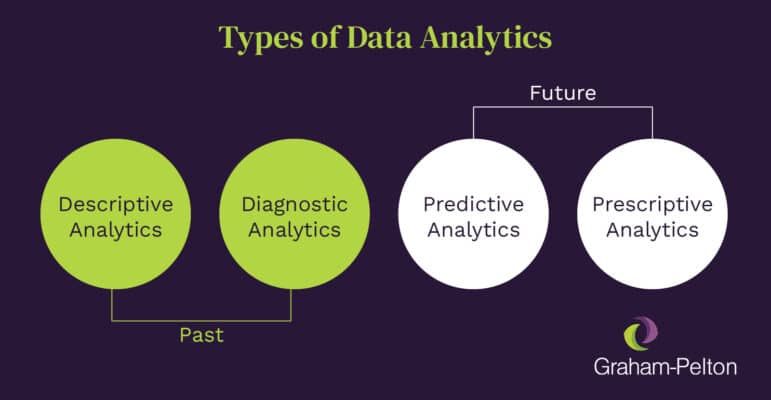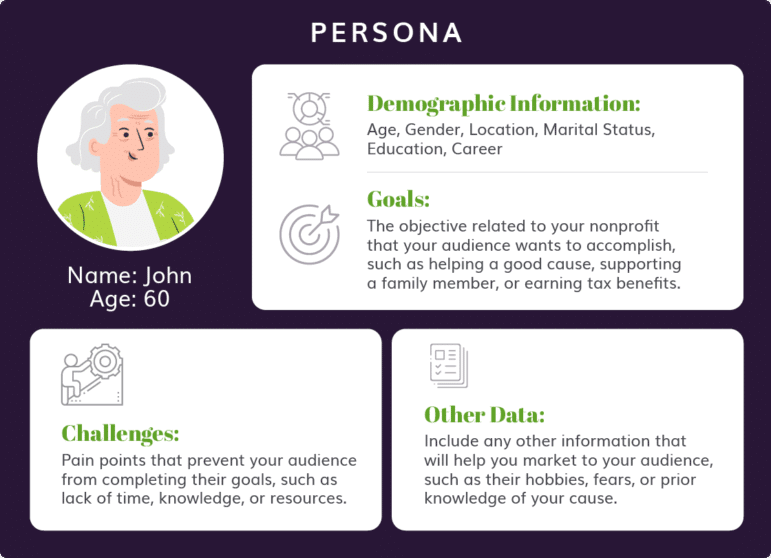Your Guide to Mastering Predictive Analytics for Fundraising

Making your best guess about the future is a significant part of nonprofit fundraising, budgeting, and planning. Since events, fundraisers, and organizational changes all require significant planning, nonprofits often set their calendars and strategic plans at the beginning of the year based on their predictions.
However, few modern nonprofits are working from hunches alone. Artificial intelligence (AI) and data modeling allow all types of nonprofits, from universities to healthcare organizations, to make data-backed decisions. With this information, they can identify valuable donors, launch successful fundraisers, and plan for setbacks.
In this guide, we will explore what exactly predictive analytics for fundraising is and how your nonprofit can leverage it.

Predictive Fundraising Analytics FAQ
What is predictive analytics?
Nonprofit data analytics is the practice of examining data to analyze and interpret it. This process turns disparate data points into interconnected trends and patterns, allowing nonprofits to better understand their current operations and plan for the future.
Predictive analytics specifically assesses data for the purpose of understanding what is likely to happen in the future.
How does predictive analytics differ from other forms of data analysis?
Predictive analytics is just one way to look at data. Nonprofits can also examine their data to discover the following:
- Descriptive analytics is the process of describing past events to better understand what took place and why. For example, you might perform a descriptive analytics assessment of a recent event to determine why it was successful and whether you can reproduce those results in the future.
- Diagnostic analytics involves taking a deep dive into data to find connections between events, identify origin points, and generally understand why things happened the way that they did.
- Prescriptive analytics is the next logical step after predictive analytics. While predictive analytics aims to determine what will happen in the future, prescriptive analytics provides guidance for what course of action you should take in that future scenario. For example, if your predictive analytics points towards a decline in small-dollar donor engagement and an increased need for major donors, your prescriptive analytics might suggest strategies for re-engaging mid-level donors or pivoting your fundraising strategy to major donor cultivation.
As this overview shows, these four types of analytics are closely related, and nonprofits can benefit from performing all of them.

For instance, your descriptive analytics helps you understand what happened in the past, and diagnostic analytics explains why it happened. This data can be used to predict what will happen in the future, and your prescriptive analytics helps you take action based on those predictions.
How does AI impact predictive analytics?
AI has dramatically transformed how nonprofits approach many parts of their operations, from content creation and messaging to analytics. Rather than relying on their teams to make sense of thousands of data points, AI can process these data sets to create predictive models.
Predictive models leverage your data to understand donor behavior and predict donors’ future actions. For instance, your predictive model might identify key characteristics shared by your major donors and scan the rest of your donor base to find other individuals who also possess those characteristics, pointing you toward supporters who might make a major gift in the future.
To process your data, consider working with fundraising consultants who have access to and understand how to use advanced predictive modeling tools.
9 Predictive Modeling Use Cases
Predictive analytics can be used to determine the future of any part of your nonprofit. Even when focused on fundraising, this technology has a wide range of uses.
1. Major Donor Prospect Research
Major donor cultivation requires extensive research, and predictive analytics can help speed up the process. This allows your major gift officers to focus on building relationships rather than digging through your donor database.
For example, predictive analytics can help you:
- Identify major giving candidates. Many prospect research platforms use predictive analytics. These tools analyze your current major donors to determine shared characteristics—such as demographic data, past giving history, business connections, real estate holdings, and other giving capacity and affinity markers—and spot other donors in your database that also share these traits. With this information, your major gift officers will understand which donors to focus their stewardship efforts on.
- Time fundraising requests. Knowing when to make your fundraising ask is just as important as knowing who to ask. Waiting too long means depriving your nonprofit of potential funding, while asking too early or at the wrong moment can risk the relationship with the prospect. Predictive analytics can assess the trajectory of your engagements with major donors and compare them to past successful asks to help your major gift officers better time their fundraising requests.
- Uncover major giving trends. Predictive analytics can let you know if your major donors or major giving program is changing or is likely to change in the future. For instance, it might spot that an increasing number of major donors have corporate connections or that the average major gift amount is falling.
When it comes to your major giving program, predictive analytics is a time-saving tool. Rather than looking into each of your donors individually, your analytics tools can assess your entire database and present the top candidates. Then, your major gift officers can take a deep dive into a handful of the most promising prospects.

2. Planned Giving Donor Identification
Similar to major donor prospecting, predictive analytics can also spot potential planned donors. Notably, a significant number of planned donors only give moderate amounts during their lifetime but are able to make a meaningful planned gift. This can make them harder to spot than major donors, as they might lack significant wealth indicators.
This analysis might also consider giving capacity, but it will also factor in age, donor lifetime value, and years engaged with your organization. This process can help you find donors who are at a stage in their lives where they are considering making a planned gift and have the means to do so.
3. Donor Lifetime Value Calculation
Donor lifetime value (LTV) is how much you predict a supporter will give over the course of their lifetime. The formula for calculating this metric is:
![[Average donor life expectancy] x [Average donation amount] x [Average donation frequency] = Donor lifetime value](https://grahampelton.com/wp-content/uploads/2025/05/predictive-analytics-for-fundraising_dlv-formula-1-771x249.jpg)
For example, if you predict a donor will give $50 to your nonprofit every month for the next 20 years, their LTV is $12,000.
However, this basic calculation doesn’t account for changing circumstances. Many donors tend to increase their giving amount over the years as they develop a connection with your nonprofit, increase their earnings potential, and make more significant gifts near the end of their lives.
With predictive analytics, you can assess how valuable donors are now and how valuable they are likely to be in the future. Use this information to refine your engagement efforts and focus on your most promising supporters.
4. At-Risk Donor Identification
Part of fundraising is holding onto the donors you have. By retaining supporters, you can build a stable fundraising base that you can rely on to contribute to fundraisers, attend events, and advocate for your cause.
However, as the average donor recapture rate is just 8.6%, the most effective way to retain your donors is to stop them from leaving. With predictive analytics tools, you can discover shared behaviors lapsed donors took prior to their departure.
For instance, your predictive analytics might spot actions such as:
- Low open rates for recent messages
- Missed recurring gift
- Expressed dissatisfaction in donor surveys
- Unfollowing your nonprofit’s social media accounts
- Decreasing their usual donation amount
Using this data, your analytics tools can identify donors demonstrating similar behaviors and flag them as at-risk. With this information, you can take a targeted approach to re-engaging these donors, whether it involves reminding a forgetful recurring donor to update an expired credit card or sending unique messages designed to renew investment in your cause.
5. Audience Persona Creation
For many of the previous use cases, we’ve touched on the concept of identifying donors with shared characteristics. To improve your marketing efforts, you can note the traits your predictive analytics tools are using to design specific audience personas.
Audience personas are a marketing planning tool that allows you to envision a specific donor rather than a broad crowd of supporters. All types of organizations use audience personas to create tailored marketing materials, predict audience reactions, and better understand their customer base.
Your personas should include detailed information that represents the audience they stand in for, including:

- Demographic information
- Goals
- Engagement history
- Interests
- Challenges
For instance, nonprofits planning a capital campaign might take the shared characteristics that their predictive analytics uses to find major donors and create a persona for this audience. They might determine that their average major donor is in their 60s, lives in the local community, has contributed to their nonprofit for at least five years, attends some fundraising events, and expressed satisfaction with the nonprofit’s direction in donor surveys.
Using this baseline, your team can then fill in qualitative parts of your audience personas (such as goals and pain points) with their own personal knowledge. Then, with a completed audience persona, your team can start testing out cases for support, outreach materials, and major giving pitches.
6. Fundraiser Response Predictions
Predictive analytics can inform you not just how well fundraising campaigns and events are likely to perform, but also how your supporters are likely to respond to specific types of campaigns and events.
When providing your analytics tools with data about past events and campaigns, make note of what the fundraiser was. For example, your nonprofit might have a strong record of hosting successful annual auctions and galas but has struggled with online crowdfunding before.
Evaluate the success of future fundraisers by analyzing:
- Which donors engaged with similar past fundraisers
- Past fundraisers’ return on investment (ROI)
- Past fundraisers’ impact on donor acquisition and retention
- Donors’ communication preferences, such as their likelihood to respond to emails, SMS, or traditional mail
This information can help you determine what activities to put on your fundraising calendar and what impact to expect from them.
7. Mid-Level Donor Engagement
Predictive analytics isn’t just for finding major giving candidates, but can be used to connect with all of your supporters. For example, for your average, mid-level recurring donor, you might use predictive analytics to assess their:
- Giving frequency
- Preferred giving methods
- Next giving amount
- Mission-related interests
- Likelihood of participating in a specific campaign
This data goes hand-in-hand with predicting donors’ LTV and your fundraisers’ reception.
8. Annual Giving Assessment
Knowing how much you can expect to raise in a given year is instrumental for setting your budget, planning fundraisers, and making strategic decisions. Predictive fundraising analytics can assess your past annual fundraisers to make logical projections for the coming year.
When analyzing your annual fundraising potential, consider past data as well as current events and wider sector trends. For instance, if your nonprofit has not seen any declines in fundraising but fellow nonprofits in your space have, you may want to factor a potential future shortfall into your estimate. For example, colleges like Harvard have recently had concerns regarding federal funding, and should factor these uncertainties into their projections.
While they should be planned at the beginning of the year, treat your budget and annual calendar like living documents that you routinely reassess based on the most current data. Like with any plan based around predictive analytics, be prepared to pivot if unpredictable circumstances occur. For example, a nonprofit that provides aid for extreme weather events may have an unpredictably busy year, causing both spending and fundraising to diverge from initial predictions.
9. Grateful Patient Fundraising Research
Healthcare organizations have unique fundraising concerns to consider, such as how to run an effective, ethical, and mutually beneficial grateful patient program. While every patient has unique circumstances, predictive analytics can help your fundraising team make strategic decisions about when in a patient’s treatment and recovery to approach them with giving appeals.
Additionally, while all nonprofits should use secure analytics tools, healthcare organizations should be extra considerate of ethical and legal concerns. When analyzing patients’ data, ensure your tools are secure and won’t share their information with other users.
Predictive Analytics for Fundraising Best Practices
Audit Your Data
By feeding predictive analytics tools accurate, complete, and relevant data, you can gain targeted insights that provide a real picture of your supporters.
Before performing any analytics processes, audit your database. Specifically, you can clean up your database by:
- Identifying and correcting missing, outdated, redundant, and irrelevant data
- Implementing data entry standardization practices
- Updating data continuously, such as by reviewing your data, asking supporters to update their profiles, and conducting data appends
Focus on Relationship Building
AI and technology can help your nonprofit organize, streamline, and maximize its data analytics capabilities. However, while predictive analytics can help you determine how best to approach donors, it’s up to your team to actually make that approach.
As such, even with the rise of AI, your nonprofit’s strongest tool is still your human bonds with your donors. Use your data insights to guide relationships, but ensure your interactions never lose that personal touch that causes supporters to make an investment in your nonprofit.
Train Your Staff
When your staff understands what predictive analytics is and how to use it in fundraising, you can start crafting future-proofed, data-driven strategies. Host training sessions, work with external consultants, and provide resources that educate your staff on:
- Data collection. Strong analytics starts with clean data. Go over your data collection practices with your team, standardize data entry procedures, and reinforce why certain standards are in place.
- Using analytics tools. For team members who will be working with your analytics tools, ensure they are trained to use this software, both in terms of how to enter data and interpret results.
- AI best practices. Nonprofits that use AI should have procedures in place for ensuring these tools are used ethically and any AI-related errors or biases are scanned for and corrected.
Work With a Fundraising Consultant
Fundraising consultants have access to advanced data analytics tools that might be out of your nonprofit’s budget to maintain year-round. Additionally, these professionals have years of experience working with sophisticated predictive models, meaning they can better understand and interpret their results.
Look for fundraising consultants with data intelligence and analytics services, like Graham-Pelton. At Graham-Pelton, we take a data-driven but human-centered approach to analytics, providing nonprofits with:
- Sophisticated tools. Our team leverages specialized AI and machine learning tools to analyze your data and gain robust insights.
- Predictive analytics. We aim to help nonprofits not just make the most of their current situations but also plan for the future. We uncover predictive analytics and provide your team with the training you need to act on this data even after your partnership with us ends.
- Enhanced donor engagement. Work with our team to analyze your data and receive hands-on, specific recommendations for how to act on it.
Getting Started With Predictive Analytics in Your Fundraising
Nonprofits that use predictive analytics for fundraising have better relationships with their donors, reliable plans for the future, and the ability to drill down into specific parts of their operations.
If your nonprofit is unfamiliar with data analytics, consider working with a consulting firm like Graham-Pelton that can handle all technical processes for you. Additionally, full-service agencies like ours can offer a range of other services as well, including:
- Fundraising Communications Consulting. Fundraising is all about communication. Get help translating your data into compelling fundraising appeals.
- Campaign Feasibility and Planning Services. Capital campaigns require a lot of data and preparation. Learn how you can use your predictive analytics to assess the success of a future capital campaign.
- Training and Workshops. Help your team develop the skills they need to act on your fundraising insights with professionally led training sessions and workshops.
